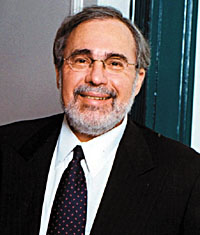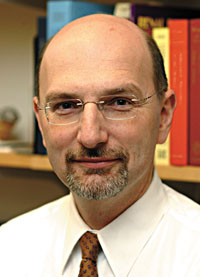 | Dr. Steven Hebert |
Two Yale physician-scientists will accept major awards in the field of kidney research in Singapore when the World Congress of Nephrology meets there in June.
Dr. Steven Hebert, the C.N.H. Long Professor and chair of the Department of Molecular and Cellular Physiology, and Dr. Stefan Somlo, the C.N.H. Long Professor of Medicine and chief of the Section of Nephrology, are being recognized for important discoveries about the kidney.
Hebert will receive the A.N. Richards Award from the International Society of Nephrology (ISN) for three discoveries in the field of ion transport and ion sensing. Somlo will share the Lillian Jean Kaplan International Prize for Advancement in the Understanding of Polycystic Kidney Disease for his work in discovering genes that cause polycystic kidney and liver diseases. Somlo and his co-recipient, Dr. Gregory Germino of The Johns Hopkins School of Medicine, will receive $50,000 each from The PKD Foundation and the ISN.
The A.N. Richards Award, which carries a $10,000 cash prize, is the highest award of the ISN for basic research in fields related to nephrology and is presented every two years at the World Congress. The award is named for Alfred Newman Richards (1876-1966), a member of the Yale College Class of 1897.
Hebert is being recognized for discoveries that have had a fundamental impact on understanding of the regulation of salt balance by the kidney. First, his group identified a critical channel that regulates potassium excretion by the kidney. Loss-of-function mutations in this channel cause Bartter's Syndrome Type II, an inherited disorder that results in loss of sodium and potassium in the urine. Hebert's group has the only viable mouse model of this disease.
Second, Hebert's group identified two sodium chloride transporters which are exclusively expressed in kidneys and that are the target sites for the most important clinically used diuretics. Changing the activities of these salt transporters alters salt and water balance and thereby controls blood pressure.
Third, Hebert's group identified a calcium-sensing receptor that contributes to the maintenance of body calcium balance. This discovery led to development of a medication, Amgen's Sensipar, for treatment of both primary and secondary hyperparathyroidism. The latter affects most of the more than 1 million patients worldwide with end-stage kidney disease.
Somlo collaborated with his Kaplan Prize co-recipient, Germino, in the discovery of PKHD1, the gene for autosomal recessive polycystic kidney disease. Most recently, Somlo discovered two genes responsible for autosomal dominant polycystic liver disease without polycystic kidneys. These latter discoveries point to a novel mechanism for cyst formation, one involving the proper folding and maturation of proteins in the cell.
Somlo's discoveries have defined polycystic kidney and liver diseases as the result of defects in channel activity and protein folding function and have suggested both of these processes may be appropriate targets for future therapies.
T H I S
Scientists cited for groundbreaking
work on kidney disease

Dr. Stefan Soml
Somlo has used molecular genetic approaches to understand three clinically distinct diseases in which harmful cysts form on the kidney or liver. Polycystic kidney disease is a life-threatening condition that affects more than 12.5 million people worldwide. Somlo led the group that discovered PKD2, the second gene for autosomal dominant polycystic kidney disease (ADPKD). His group then developed a mouse model to show that cysts in the kidney and liver form by loss of the previously normal copy of the PKD2 gene. Somlo went on to show that the protein product of the PKD2 gene, polycystin-2, functions as a channel that passes positively charged ions, and that loss of the channel function results in ADPKD.
 W E E K ' S
W E E K ' S S T O R I E S
S T O R I E S![]()
 Staff, students unite to stage benefit concert for tsunami victims
Staff, students unite to stage benefit concert for tsunami victims![]()
![]()
 New track pays tribute to Eli Gold Medal winner
New track pays tribute to Eli Gold Medal winner![]()
![]()
 Three students named All-USA College Academic Team
Three students named All-USA College Academic Team![]()
![]()
 Volunteers lend support to students with special needs
Volunteers lend support to students with special needs![]()
![]()
 Scientists cited for groundbreaking work on kidney disease
Scientists cited for groundbreaking work on kidney disease![]()
![]()
 Exhibit, symposium highlight work of architect Eero Saarinen
Exhibit, symposium highlight work of architect Eero Saarinen![]()
![]()
 Law School symposia to offer new views on timely topics
Law School symposia to offer new views on timely topics 'Breaking With Tradition' will explore the issues surrounding . . .
'Breaking With Tradition' will explore the issues surrounding . . .![]()
 'U.S. Colombia Policy at a Crossroads' to assess potential . . .
'U.S. Colombia Policy at a Crossroads' to assess potential . . .![]()
![]()
 Researchers find missing genes of ancient organism
Researchers find missing genes of ancient organism![]()
![]()
 'Body Memories' explores breast cancer through arty
'Body Memories' explores breast cancer through arty![]()
![]()
 YaleGlobal Online reaching record number of readers
YaleGlobal Online reaching record number of readers![]()
![]()
 Neuro-oncology fellowship supports the study of brain tumors
Neuro-oncology fellowship supports the study of brain tumors![]()
![]()
 Forlorn forecast: Spring is near, but not yet hereh
Forlorn forecast: Spring is near, but not yet hereh![]()
![]()
 Sletcher, editor at Benjamin Franklin project, to talk about his book
Sletcher, editor at Benjamin Franklin project, to talk about his book![]()
Bulletin Home |
| Visiting on Campus
Visiting on Campus |
| Calendar of Events
Calendar of Events |
| In the News
In the News![]()
Bulletin Board |
| Classified Ads
Classified Ads |
| Search Archives
Search Archives |
| Deadlines
Deadlines![]()
Bulletin Staff |
| Public Affairs
Public Affairs |
| News Releases
News Releases |
| E-Mail Us
E-Mail Us |
| Yale Home
Yale Home